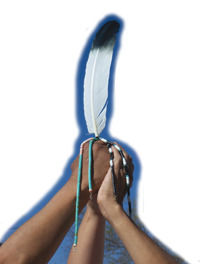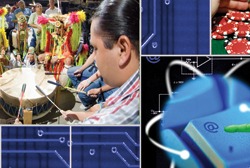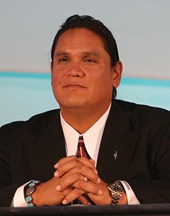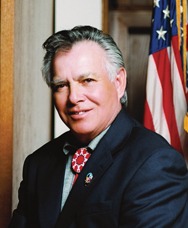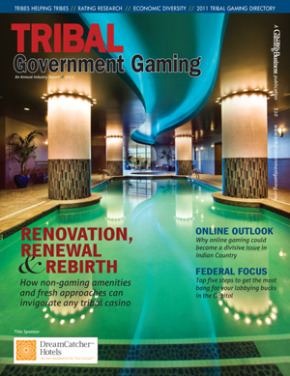
Native American casinos have come a long way since the early days of putting up a prefabricated gambling hall—or a tent. Today’s lavish, full-service tribal casino-resort destinations offer everything from branded restaurants to upscale retailers, luxurious hotels to state-of-the-art theatres, sumptuous spas to signature golf courses—and of course, expansive and alluring gaming floors.
While making adjustments for the economy, renovation, renewal and rebirth are proceeding at a steady pace at Native American casinos. And every addition, update and new construction project results in more excitement and appeal for customers, and more pride—and profit—for tribes.
In late 2009, council members of the Sovereign Nation of the Coushatta Tribe, managers of the tribe’s casino resort in Kinder, Louisiana, and architects from the Memphis-based Hnedak Bobo Group met in Las Vegas during the Global Gaming Expo.
“We challenged them,” says Conrad Granito, general manager of the Coushatta Casino Resort. “We had been planning a major remodel of upwards of $250 million. But given the financial conditions at the time, we said, ‘What can we do?’ Hotel rooms were our major need, but at what level of finish? We wanted a four-star hotel at a three-star price.”
Dike Bacon, director of planning and development at Hnedak Bobo Group, says it was a tall order.
“Yes, they challenged us to set a new standard for their hotel, focusing on high-end features and amenities that would fundamentally change their guests’ notion of the casino hotel experience,” says Bacon. “We believe the concept we’ve established has the potential to change how casino hotels in Indian Country will be developed and ultimately marketed to the gaming customer.”
The new $60 million, seven-story, 400-plus-room hotel at Coushatta Resort Casino will be the first to be developed by DreamCatcher Hotels, a new, separate hotel development company that grew out of Hnedak Bobo Group. Scheduled to open in 2012, it will feature distinctive touch points, including luxurious linens and even a custom-designed DreamCatcher-brand mattress.
“We want guests to walk into their room and say, ‘This is nice!’ but we don’t want them to hang out in there for two days,” Granito says. “The room will be oasis, a place you like to go back to from gaming.”
SHELVING THE SELF
The Coushatta renewal project is a perfect example of how, “instead of simply dusting off original plans shelved at the advent of the recession, tribes that are in a growth mode are taking fresh, aggressive views of the bottom-line performance metrics of their new investment activity and changing their expansion plans accordingly,” Bacon says.
Adds Dick Rizzo, vice chairman of Las Vegas-based Perini Building Company, “Tribes are saying, ‘Let’s see what today’s dollars can do for us.’ Our original master planning may have involved a casino, then a hotel, then expanding the casino and adding more hotel rooms, but we had to put the brakes on it. Now maybe we can do another piece.”
With construction projects pricing out at about 10 percent to 15 percent lower than just a few years ago, tribes are adding those pieces. In fact, Barry Thalden, a partner at Thalden Boyd Emery architects in Las Vegas, says his firm anticipates opening six new Native American projects in 2011.
“Smart casino owners are expanding and renovating their casinos now,” he says.
Tom Hoskens, vice president at the Cuningham Group, Minneapolis, notes, “To take advantage of current construction prices, if one has the wherewithal, you can get great value now. It’s the right time to plan and design, and move projects forward.”
In addition to lower construction costs, several other factors are contributing to the optimism of the Indian gaming segment of the industry.
“Gaming consumer discretionary spending is up,” says Bacon. “The finance community is becoming more receptive to deals. The lodging segment and travel are improving nationwide. These are all strong signals that should give tribal leaders the confidence to proceed with the right investments for growth.”
GROWTH AND DEVELOPMENT
What are the right investments?
“Let’s say it’s 2011 and a tribe looks at revenues and decides it has enough to expand. What’s happening today is everyone’s looking a lot harder to see if it makes sense,” says Brad Friedmutter, chief executive officer of Friedmutter Group Architects, Las Vegas. “It’s very different from just a few years ago when the attitude was, ‘If you build it they will come.’”
Brian Fagerstrom, president of WorthGroup Architects, Denver, agrees.
“Tribes are way beyond ‘build it and they will come’ now,” he says. “They’re doing more homework these days to really understand their demographics—what existing clients want, and who management wants to attract to the property.”
For example, Fagerstrom says, when the Choctaw Casino in Durant, Oklahoma was undergoing a rebirth (all seven Choctaw Nation of Oklahoma properties were transformed between 2007 and 2009), management surveyed customers regarding restaurant preferences. Based on the results, Fagerstrom says, “Some of the original planning got scrapped in the middle of design. We’re getting better information on clients and that really affects rebranding.”
Branding is something that Native American tribes understand.
“They’re increasingly bringing fun, name-brand restaurants and retailers such as a Bass Pro Shop or Cabela’s onsite, or totally rebranding as a Hard Rock, for example, to attract people to their place rather than someone else’s,” Hoskens says. “It creates an edge in a competitive marketplace. It’s a popular trend now and it works.”
Joel Bergman, chairman and chief executive officer of Bergman, Walls & Associates, believes that tribal casinos now need something to stand out.
“Sometimes an outside operation can bring a different flavor to a venue,” he says. “A nationally known restaurant will open in a Native American casino and will be operated by an outside vendor—that started in Las Vegas with celebrity chefs and it really spices up the offerings and adds pizzazz. To see that starting to happen in Native American casinos is very exciting.”
Lisa Jelliffe, director of marketing and business development at WorthGroup, says tribes’ use of branding indicates they are very sophisticated in understanding the marketplace and how customers want to spend their money and time.
Whether a Native American casino r
equires a renovation, renewal or rebirth is no longer a discussion.
“The question owners should be asking is, ‘What can we do for our customers that will knock their socks off?’” says Thalden. He points out new hotel rooms and parking structures “typically bring the best results to the bottom line.”
The life cycle on hotel rooms with an occupancy rate of 98 percent is about five to seven years, Rizzo notes, “so they definitely need to be renovated or remodeled periodically.”
Smart Native American casinos, he adds, “are constantly repositioning entertainment venues, replacing the Chinese restaurant with a steakhouse, just to offer variety and keep it fresh.”
RENEWED ENTHUSIASM
Renovations do not have to be major to make a big difference.
“From adding a small restaurant or spa, new bedding in the guest rooms, to simple things on the gaming floor like making sure the carpet’s not worn out, it gives the perception you’re taking care of your property and your clients,” says Fagerstrom.
As part of a maturing—but competitive—industry, Native American casinos across the nation are involved in, or contemplating, property renewals. When the Choctaw Nation renewed its seven Oklahoma casinos, “in order to serve a growing market and remain competitive, the flagship property in Durant especially needed to have a different image,” says Fagerstrom, “so it grew from a first-generation property to a major regional destination.”
Everything from design and materials to employee training and guest experience were addressed. Jim Mickey, a principal at WorthGroup, adds technology also played a major role in generating and maintaining interest and awareness, including weekly “Behind The Design” videos, social media and internet access inside and outside the property.
“The success of a Native American or any casino is way past growing by gaming now,” he says.
Thalden Boyd Emery designed the $45 million renewal that will be completed in September at the Wildhorse Resort and Casino in Pendleton, Oregon. Owned by the Confederated Tribes of the Umatilla Indian Reservation, the current 99-room hotel will be expanded by a 10-story, 184,000-square-foot, 202-room addition with wall-to-ceiling windows overlooking the Blue Mountains, plus there will be a new indoor/outdoor pool, retail space and a four-screen cinema, and the casino will grow by 24,000 square feet.
“We’re upgrading the front entrance of the casino while expanding the property,” Thalden says. “That gives the impression of a totally new casino.”
The casino opened in a metal pre-fab building in 1995 while the original 40,000-square-foot casino was being built; it has gone through several expansions over the years but none as dramatic as the current renewal.
At Mystic Lake Casino Hotel in Prior Lake, Minnesota, owned by the Shakopee Mdewakanton Sioux Community, Bergman explains a renewal program actually has been ongoing for several years.
“We have been adding amenities to the venue, through good times and not so good,” he says.
One of the primary projects has been the creation of the remarkable “river of flames” that runs along the ceiling of the property. “It ties together several chunks of the casino that had been added over time, to unify it into a single composition. It really has pulled the place together,” Bergman says. Over time, in addition to expanding the casino, Mystic Lake has added restaurants, a showroom, a golf clubhouse, a 14-story hotel addition and more.
“We are more like a huge locals place,” says General Manager Rich Langelius.
The Hard Rock Hotel and Casino in Albuquerque, New Mexico, is owned by the Pueblo of Isleta, and was re-themed as a Hard Rock.
“The tribe wanted an addition to their casino and they didn’t have a hotel, so we designed a hotel, a conference center, restaurants and a spa, and added it all onto the casino, which stayed the same,” Hoskens says. “The hotel lobby is all glass, very unique and modern, with a soaring 90-foot atrium. It’s got a lot of ‘wow!’”
Hoskens also has been involved in an impressive casino rebirth at Harrah’s Cherokee Casino & Hotel in Cherokee, North Carolina, owned by the Eastern Band of Cherokee Indians. Originally opened in 1997, the five-year, $633 million expansion is the sixth-largest construction project in the U.S. Highlights will include a 21-story hotel tower adding 532 rooms and suites overlooking the Great Smoky Mountains; Paula Deen’s Kitchen restaurant; a food court; the luxury Mandara Spa; a 3,000-seat events center; and a casino expansion to 195,000 square feet.
“Outside, the building has been designed to reflect the mountains with soft, curved layers and windows symbolic of spruce and pine trees. There’s a trout stream that flows through the property and it’s not unusual to see people fishing there,” Hoskens says. “Inside, the design is a metaphorical journey through the Great Smoky Mountains in four zones, to help people feel oriented and comfortable.” The rebirth has “totally changed and freshened and enlivened the casino resort,” Hoskens says. “There’s a lot yet to come.”
WESTERN WAYS
Across the country, the Cache Creek Casino, Brooks, California, owned by the Rumsey Band of Win-tun Indians, started out as a modest bingo hall in a pre-engineered building in 1985.
“At first a tribe usually doesn’t have a lot of money available, so they put up something relatively inexpensive,” Friedmutter says. “Then through good management and marketing they become successful and can get investors in order to expand. So in 2004, although the land in trust was limited, the tribe wanted a major expansion.”
A $200 million rebirth began—the construction of a ground-up casino resort with a 74,720-square-foot gaming floor, 200-room hotel, spa, restaurants, theater, event center and an 18-hole championship golf course, all completed in 2008.
“It’s a very exciting property that caters to clientele that previously were geographically cut off from going to Tahoe,” Friedmutter says.
Similarly, the Kalispel Tribe of Indians recently completed a new 250-room hotel and 50,000-square-foot casino expansion at its Northern Quest Resort and Casino in Airway Heights/Spokane.
“The property opened as a humble 50,000-square-foot casino in December 2000,” Bacon says. “Now, 10 years later, the addition significantly raises the quality level in the marketplace and the resort has become a destination escape for visitors from Seattle to Portland.”
The casino resort recently earned AAA’
s coveted four-diamond award ranking, making it the only Native-owned property in the region to receive this recognition.
TRIBAL HERITAGE
There are dozens of other examples of renovation, renewal and rebirth at Native American casinos. Most of them, in one way or another, reflect the tribe’s culture and history within the interior and/or exterior design. That can be accomplished in many ways. For example, a dazzling multi-media show is planned at Harrah’s Cherokee, showcasing the nation’s themes and culture in a 50-foot-high rotunda encircled by eight columns, with a waterfall, stage and landscaping.
“It’s the crescendo to the composition,” Hoskens says.
Or, a tribe’s heritage can be reflected in more subtle ways, such as at the Choctaw Casino in Durant, Oklahoma.
“We used a lot of things from the tribe’s culture like baskets, prairies, colors and imagery as inspirations to create patterns and textures,” Mickey says.
For example, the snake, an important tribal image, is reflected throughout the Diamondback Lounge. “But it’s not literal,” Mickey notes. “The shape and exterior skin of the building also reflect the pattern left by a snake as it wanders through the sand.”
At the Four Winds Casino Resort in New Buffalo, Michigan, owned by the Pokagon Band of the Potawatomi Indians, visitors can learn about the tribe’s history through a series of murals in the rotunda painted by renowned Native American artist Mike Larsen. A kiosk describes each mural.
“In designing the facility we wanted to make sure our cultural traditions were visible,” says Pokagon Chairman Matt Wesaw. “We did not want the casino to define the Pokagons.”
Four Winds is experiencing a renewal now, Wesaw says, working with Hnedak Bobo Group to add 250 hotel rooms, an entertainment center, conference facilities and a restaurant.
“The property is such a source of pride for our 4,400 tribal citizens,” he says. “Equally important, it’s an economic engine for the tribe and has enabled us to have our own courts, social services, education, housing and police force.”
STAYING CURRENT
Renovation, renewal and rebirth also are very positive for tribes, Hoskens says, “because they can see their business expanding and growing and that their business leaders are doing a good job. These projects are a strong indication to the tribe that they will be even more successful in the future.”
Additionally, Rizzo points out, “Many of these tribes were destitute before they had the ability to own and operate casinos. Because of gaming, they’re less dependent on the federal government and taxpayers for survival.”
What will the future of renovation, renewal and rebirth at Native American casinos look like? The next cycle of change is starting to happen already, Bergman says.
“As these casinos continue to mature they will add on seriously big chunks—multi-screen movie theaters, bowling alleys, larger hotels, bigger bingo halls. They’ll become more complete as resorts,” he says. “They’ll become mainstream.”
Mickey says that every tribal casino, like every tribe, tells a different story.
“It’s interesting how every Native American casino has hundreds of machines and a restaurant,” he says. “Yet every one of them is completely different, with so many levels and variations. There’s no single design like a McDonald’s franchise. Each one expresses a brand new journey.”





